Moules Road
Moules Road Magill/Rostrevor: A nice place to live
This article is a snapshot of life on Moules Road, Magill and Rostrevor. Information has been obtained from newspaper articles and the resources listed at the end of the article. Any errors are the author’s and we would appreciate any information that will increase the value of the article.
Moules Road forms the boundaries of Sections 341 and 292 of Light’s survey of the Hundred of Adelaide. Section 341 (Woodforde) was originally granted to George Fife Angas and others while Section 292 (Rostrevor) was held by Charles Burton Newenham (Leaney p31-32).
Robert Moule and his wife Elizabeth arrived in South Australia on the Thetis in 1851. They owned 56 acres (approximately 23 hectares) of land in Sections 341 and 292, originally called South Stradbroke and now are part of the suburbs of Magill and Rostrevor. These sections are part of the Council’s Woodforde ward and this name was often used when referring to the area. Robert was elected to the District Council of Campbelltown in 1875 and 1876; his grandson Allan Robert Moule was also a Councillor from 1951.
Robert Moule and his family purchased the land from Richard Beetson which is now occupied by Norwood Morialta High School. Their farmhouse was on the corner of St Bernards Road and Moules Road and the farm produced dairy products, ‘vegetables, fruit and nuts, poultry and pigs and grape from vines that grew where the school buildings now stand’. (Warburton p239)
Moules Road had its beginnings as a named street when the District Council of Campbelltown passed a resolution to name the road that passed Robert Moule’s property after him. It is reported that Edwin, his son, disliked the name and used to go out at night and take the sign down. (Warburton p239). Council minutes (1913/14 page 548) indicate that there had been ongoing discussion about the name of the road. The developers of Rostrevor Estate requested that it be known as Rostrevor Road, which had been included in advertising for the sale of the land in October 1913 (see the estate plan below). Council however recorded that ‘the road… has been named Moule's Road out of respect to the memory of a former member of this Council and no alteration in the name of that Road will be permitted.’
A major subdivision in 1913 divided the land east on Moules Road from Grantley Avenue on the north side and from what is now number 46 to Glen Stuart Road. One hundred and fifteen ‘home plots’ were offered for sale from £20 ($40) to £70 ($140). The following promotional material shows how enthusiastic the developers were in their description of the land. The advertisement stressed that ‘“Rostrevor” residents, in addition to the charms of their own property, will also enjoy the unique advantages conferred by the close proximity of the magnificent Morialta …Reserve, which will provide an abundance of pleasant recreation amidst the most glorious scenery imaginable.’

The sketch below illustrates the views west and also the location of the tramline.
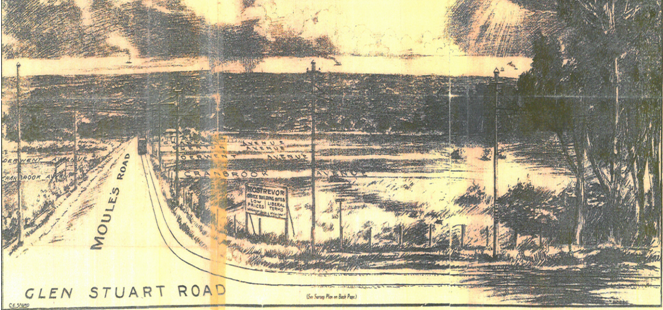
Rostrevor Estate, Public Auction, October 2, 1913 at 2.30pm
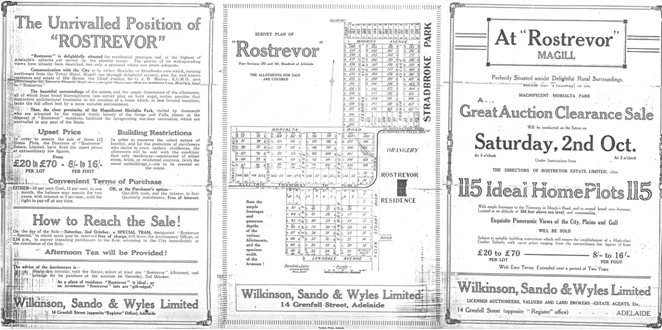
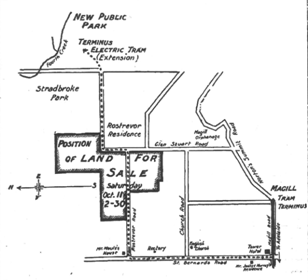
The Advertiser, Tuesday 7 October 1913, p13
Another subdivision, advertised in October 1920, listed allotments on Moules Road for prices ranging from 11 shillings, 6 pence to 19 shillings ($1.50-$2.00) per foot – only a slight increase in value since 1913!However by 1954 land was advertised for sale at £630 ($1260) for a block that was 90x180 feet (27x54 metres).
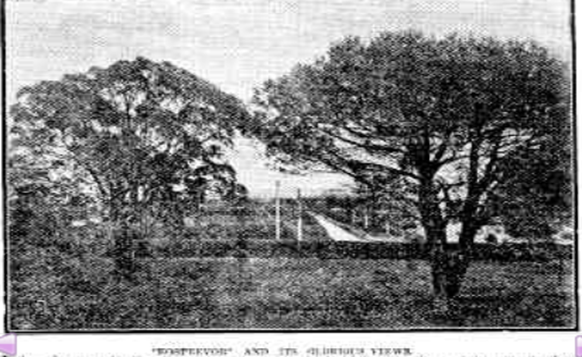
The view west, down the tramway on Moules Road. The Register 23 September 1920, p5.
Based on information in the Sands & McDougalls directories, the number of occupied properties increased from less than five residents in the 1920s, growing slowly after the late 1940s until the twenty-first century when individual properties are now being subdivided and multiple residencies on many of the properties. A count during July 2015 indicates 63 dwellings and 3 vacant blocks plus one block with grapevines and fruit trees – a growth typical of the City of Campbelltown.
Life on Moules Road
Mrs Louisa Durward, grand-daughter of Robert and Elizabeth Moule recounts life on Moules Road during the period when she and her family and grandparents lived on the farm:
‘My brothers and sisters and I were born in a stone cottage that was on our farm, facing Moules Road. Our grandparents lived right at the corner, in an old house that was partly pug – the 1923 earthquake shook it badly. The house as sheltered by trees: an enormous gum tree there was planted by my grandmother when she first came to this country. The PMG took it out – and planted another gum tree! It died, and no wonder…..’ (Leaney p130)
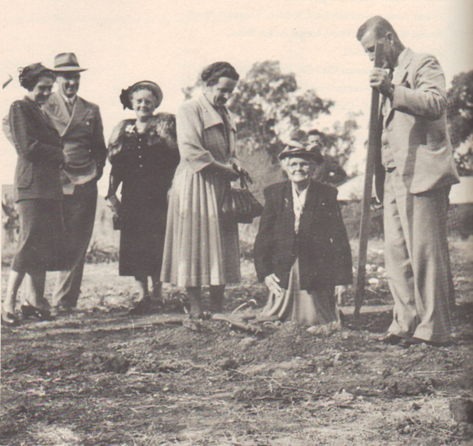
‘All sorts of traffic used to go by – men on horseback, mil carts, gigs, drays loaded with hay or vegetables or firewood, bullock wagons with heavy loads like logs and timber, farm machinery, bricks, stone…’ (Warburton p239)
Many of Robert and Elizabeth’s descendants still live in the City of Campbelltown. Robert died in 1904, Elizabeth on 6 January 1909 and both are buried in St George’s Church graveyard.
The early settlers were typical of the Campbelltown area: farmers such as the Moule family, gardeners, trades people and civil servants. It is unlikely that any farmers still live on the street but the residents would continue to represent a cross section of occupations across the Council area.
Trams, electricity and letterboxes
The Magill service of Adelaide’s electric tram system was extended in March 1915 from Magill Road, along St Bernards Road and Moules Road to Morialta. The tram track was higher than the road which caused some problems for the Council with reports in the press during 1925 that as a result, the road was ‘in a bad state’. The service ran until February 1956 and replaced by the current bus services. The tram tracks were taken up in 1957. In 1916, an article in the Register reported that there had been 5,216 trips on the tram along the route from the city to the terminus during the previous year.
In 1954 trams was the subject of correspondence in The Advertiser (13 October 1954) from an ‘Anxious parent, Rostrevor’ that the trams were travelling too fast. This letter followed press reports of an accident when a tram was derailed due to a stone on the track,– the tram ‘jumped the track and career crabwise across the road. Twenty passengers were on board but no-one was hurt’ (The Advertiser 2 October 1954).
Speed Of Trams
To the Editor
Sir – It has been a common practice for trams to be driven at reckless speeds from Magill along St Bernards’ road.
The recent derailment of a tram on Moules road points to the danger of this practice and to the need for greater caution by tram drivers. “Anxious Parent.” Rostrevor.
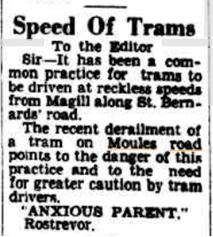
The Advertiser 13 October 1954, p4
The residents lobbied for a letterbox in the 1920s.The petition was for a box to be located at the Glen Stuart Road end of Moules Road. However, the decision was made to locate it near St Bernards Road: to ‘provide facilities for a greater number of residents’.
Rostrevor Letter Pillar
Mr. E. L Parsons, M. H. R., is advised by the Deputy-Director of Posts and Telegraphs that the department, while not able to accede to the petition for a letter receiver at corner of Glen Stuart and Moules roads, Rostrevor, it has given instructions for erection of a receiver at the Moules and St. Bernard’s roads, which position is more centrally situated, and provide facilities for a greater number of residents.
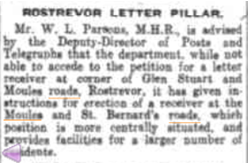 The Register 15 September 1928, p14
The Register 15 September 1928, p14
Sodium vapour lights were installed as street lighting during 1923.
Flower gardens, olive oil and shops
Koongarra Tea Gardens
Carl Barnhardt Weiss opened the Koongarra Tea Gardens in 1922 on the corner of Moules Road and Egerton Avenue, at what is now 37-39 Moules Road. Specialising in dahlias, the Weiss family advertised regularly in the newspapers supplying flowers and plant stock and won many awards at the annual Adelaide Horticultural Show. Weiss also opened a florist shop on Magill Road. The Tea Gardens operated until the 1970s.
Tea Gardens at Magill
Nobody is better known in local flower circles than Mr C. B. Weiss, a successful young amateur, who has opened a tea garden at Moule’s road, Magill. His name has figured conspicuously in the leading awards at the principal and specialist flower shows, particularly with dahlias and sweet peas. About seven years ago Mr. Weiss started to take a keen interest in floriculture in his comparatively small garden at Monteith. By dint of hard work and application he worked his way to the forefront of amateur exhibitors. About 18 months ago he purchased three and a half acres of ground at Magill, off the tramline, and in his spare time threw his heart and soul into transforming an open space into a wealth of flowers. He recently forsook the close confines of a Government office for a more healthy and fascinating calling, and is now well established in his new quarters, where he gives a cordial welcome to flower-lovers.
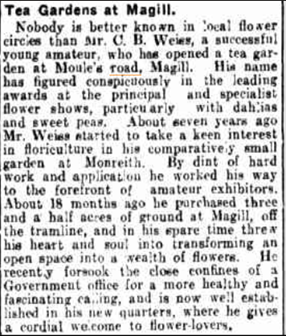
The Observer 19 August 1922, p10
Gladioli Catalogue
From Mr. C.B. Weiss, Koongarra Gardens, Moules road, Magill, I have received a comprehensive list of choice gladioli, which are offered to garden lovers.
All the well-known gladioli varieties are included as well as the more recent introductions and the prices asked range from the modest sixpence to several shillings each.
Mr. Weiss also features the primulinus hybrid gladioli, a new race that is gaining rapidly in popular favour because of its rich coloring and slender growth, which adapts itself so nicely to decoration.
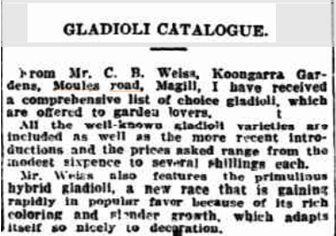
The Mail 26 July 1924, p23
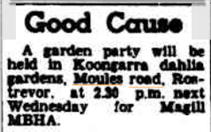
The Advertiser 14 April 1954, p18
Olive oil production
Mr Giovanni Beltrame commenced production of olive oil on his property at 22 Moules Road in 1944. He didn’t grow olives but as the advertisement below indicates, purchased the olives and processed them at Moules Road.
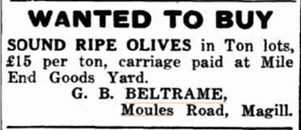
Northern Argus 9 June 1944, p3
Shops
A shopping centre, Koongarra Court, opened in 1958 at the corner Angas Road. Shops included Ward’s Four Square Grocery, hardware shop, hairdresser, children's wear, doctor, chemist, shoe shop, butcher, ‘Fancy Goods’, fruit and vegetable and a delicatessen. Part of the shopping centre remains and is known as Rostrevor Village Shops and is occupied by a restaurant, childcare centre, beauty therapy and a survey and design business – all reflecting the changing shopping habits of the residents of the street.
Rostrevor Village Shops were demolished in 2020 and a two-storey childcare centre called Goodstart Early Learning Rostrevor was opened on the site in January 2021.
The commercial facilities in the street were enhanced by the opening of Koongarra Motors in 1965 on the corner of Moules and St Bernards Roads. The service station is now St Bernards Motors and the shop next door is now a business which edges carpet.
Schools
Rostrevor College opened in May 1923. The following report of the opening ceremony included information about the site and the adaption of ‘Rostrevor’ from private home to a school for boys.
Rostrevor College To Be Opened on Sunday
The beautiful mansion, Rostrevor, will be officially opened as a boarding and day school for students of Christian Brothers College tomorrow (Sunday) afternoon. Archbishop Spence, after blessing the building, will take the platform……
….Rostrevor, which was recently purchased, originally belonged to the late Mr. Ross Reid and later passed into the hands of the late J. S. Reid. The estate then comprised the whole of Morialta National Park and the present district of Stradbrook. The former part of the estate was handed over to the Government, and the remainder was subdivided, 40 acres of orchard being left with the Rostrevor homes. The building is one of the finest residences in South Australia. The architects were Messrs. English and Soward. It has an imposing front in the Romanesque style. A feature of the building inside is the magnificent hall, the tiling of which is probably unsurpassed. The building contains approximately 30 rooms. Additional structures have been erected since the property was purchased by the Christian Brothers, and others are in course of construction to provide dormitory and school accommodation. The edifice, which stands about 500 ft. above sea- level, overlooks the whole of the city and suburbs as far as the sea. The Christian Brothers are spending £3,000 on additions, and contemplate putting another story on the main building, with a flat roof, on which will be provided sleeping out accommodation.
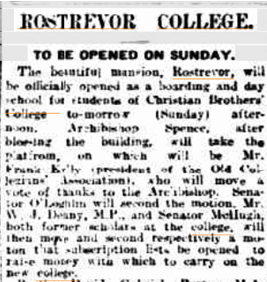
The Advertiser 5 May 1923, p13
At the St Bernards Road corner, the Commonwealth Government opened the PMG Linemen’s Training School in 1953 on the site of the original Robert Moule farm. The Training School operated until 1975 when the site became Norwood Morialta High School.
Morialta High School opened to 540 years 8 and 9 students and 45 teachers in 1975 as Morialta High School. The founding Principal was Mr. Ian Laslett. The school won awards for its innovative open plan design and the photograph below was taken in 1979 by a then student. The school was amalgamated with the Norwood High School in 1993. The site is now the middle Campus of the Norwood Morialta High School.
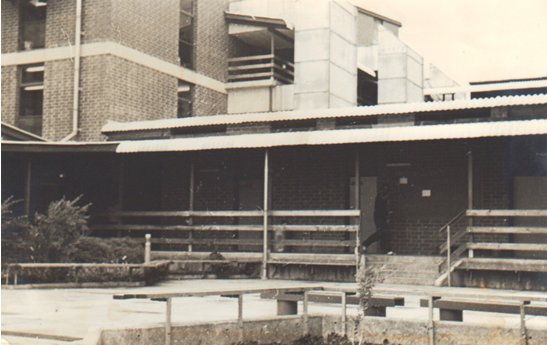
If you have any comments or questions regarding the information in this local history article, please contact the Local History officer on 8366 9357 or hthiselton@campbelltown.sa.gov.au
References
- Leaney, John T 1968 Campbelltown 1868-1968 Adelaide, Corporation of the City of Campbelltown
- National Library of Australia Trove [newspaper database] www.trove.nla.gov.au
- Warburton, Elizabeth 1986 From the river to the hills. Campbelltown 150 years Adelaide, Corporation of the City of Campbelltown
